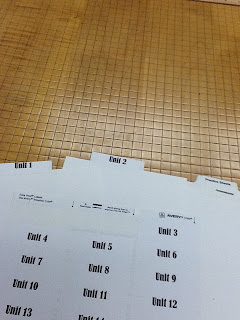Here are a few fun ideas that you can use as fillers during these first few days/weeks of school.
TIME CAPSULE

Have each child bring a Pringles can and decorate the outside, creating a time capsule. They can then fill the time capsule with a handwriting sample, a tracing of their hand, a piece of string that's as tall as they are, a self portrait (or actual picture), a list of their favorite things (favorite music, movies, sports, hobbies) etc. The kids then seal their time capsules and "bury" them somewhere (which might be just in a cupboard in the classroom). Time capsules can then be opened at the end of the school year. You could also just have a single class time capsule and just have the students put one thing in it (such as a letter to themselves or an "All About Me" sheet. That way you only have to deal with one time capsule instead of 25.
CLASS QUILT

Give each child a square sheet of white paper (5x5, or 8x8) and have them decorate it with their name, drawings of their family, drawings of their favorite things, etc. Punch a hole in the corners of each sheet of paper and then tie the papers together with yarn to create a large class quilt that can be displayed in the classroom or hallway. The teacher would want to model how to do this or create a quilt square prior to the lesson. A fun story that goes along with this is "The Rag Coat" by Lauren Mills. It is in the 4th grade literacy place book "Chapter by Chapter" if you need a copy.
SUMMER REFLECTIONS OR SHADES OF SUMMER

This is an easy activity that students enjoy doing, which also serves as a chance for the teacher to get a quick indication of students' writing abilities.
Each student draws a large pair of sunglasses. In the sunglasses, the student draws something he or she did over the summer...a trip, activity, etc. They then attach a paragraph about what is reflected in the sunglasses. This is an opportunity to get an early writing sample and also makes an instant bulletin board! You could also do the same thing using a picture of a windowpane and call it "View From My Window".
ME Bags or Boxes

A tried and true lesson idea for the first days of school is to put items in a bag or box that represent you (the teacher). For example, a picture of your family, a pair of running shoes because you like to run, a whisk because you like to cook, etc. You can then send home a small bag or box with each student and have them fill it with their favorite things. Throughout the rest of the week you let students take turns sharing their "ME" boxes.
Sticker Partners

Each student is given a sticker to put on his or her hand upon entering the classroom, but students aren't told what the sticker is for until the time is right! Be sure there is a partner (matching sticker) for every student. Ask students to find their partners and interview them (name, grade, hobbies, etc.). Each interviewer is responsible for introducing each interviewee to the rest of the class. You might find that students find it less threatening when someone else shares information about them than when they are asked to share about themselves.
Paper Dolls!
Cut out paper doll shapes from cardstock. All are alike in the beginning. Then students "dress" their dolls by coloring or making clothes out of fabric, wallpaper, etc. Tell them to leave the face portion blank. Use the digital camera to take pictures of the students. Crop the pictures so that you see only faces, blow them up to fit the paper dolls, cut them out and glue them on. Students and parents love them! At the end of the year, students take their dolls home.
The Me Shield
For this activity, we use a copy of a banner from a Red Cross education program, drawn like a shield and divided into four sections. We pose seven questions students can answer about themselves:
What are three things you are good at?
What do you like most about your family?
What do your friends like about you?
What do you think you can do better than almost anyone else your age?
What do you dream about doing one day?
What is something you have already done that makes you feel really good?
What is one thing you are planning to change about yourself so you will be even better?
Each student writes his or her name at the top of the paper and answers four of the seven questions, one answer per section, on the banner. Students can write their answers or use a combination of art and writing to express themselves. The students volunteer to share their banners, and the teacher can proudly display them after the students have had a chance to decorate them.





























































